|
Aoshima's 1/700
scale IJN
Soryu (Blue Dragon)
by Don Hinton
|
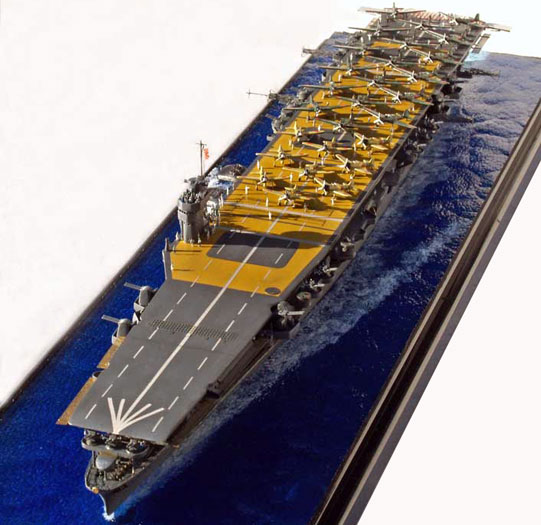 |
|
Soryu (Blue
Dragon)
Imperial Japanese Navy
December 7, 1941 |

Aoshima's 1/700 scale Soryu is available online from
Squadron.com
Soryu was Japan’s first modern aircraft carrier of
WWII. Built by the Kure Naval Dockyard, she was launched on December
21, 1935. She had an overall length of 746 feet 5 inches and a beam of
69 feet 11 inches, weighed 18,800 tons and carried 54 aircraft with nine
spares for the attack on Pearl Harbor. Her light construction allowed a
high speed of 34.5 knots but made her vulnerable to attack.
On December 7 1941, Soryu spotted 27 Kates and
Zeros for the first of two launches. One Zero suffered a technical
malfunction and didn’t launch, thus Soryu launched 26 aircraft on the
first attack wave against Pearl Harbor and other military facilities on
Oahu. On the second Soryu launch, 27 aircraft were again spotted but
one Kate failed after launch and returned, again leaving 26 aircraft to
attack Oahu.
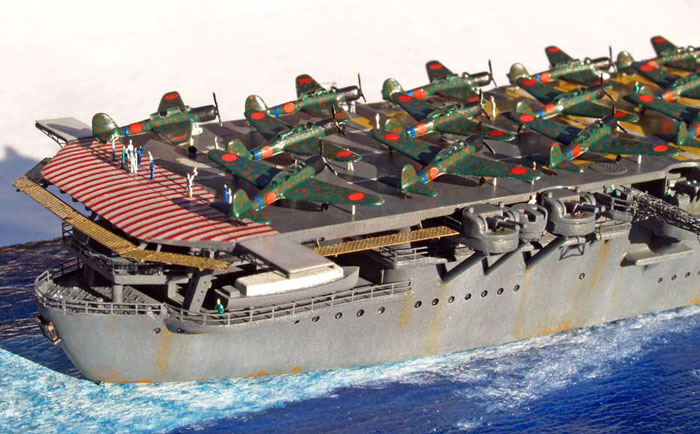
On 4 June 1942 during the Battle of Midway, Soryu
was heavily damaged by SBD Dauntlesses from the USS Yorktown and then
the USS Natulus (SS-168) claimed to deliver the final blow with two
torpedoes. Soryu sank northwest of Midway Island.
IPMS Battleship Row’s IJN Carrier Project
|
IPMS Battleship Row Hawaii conducts several model
displays each year at the USS Arizona Memorial Visitors Center, as well
as other displays around the island of Oahu.
At the USS Arizona Visitors Center we are usually
located by the entrance just across from the Arizona’s anchor, ensuring
every visitor sees our display around Memorial Day (last Monday of May)
and December 7th of each year. The club’s centerpiece is a
1/2400 diorama of Battleship Row as it appeared the morning of December
7th 1941 before the attack. In the summer of 2006, to expand
our December 7th display we decided to build all six of the
IJN aircraft carriers involved in the attack on Pearl Harbor.
Our timeline was December 1 2006 for the 65th
Pearl Harbor Symposium. Due to the short time allowed to build the
ships, as well as professional commitments by the other builders, the
Soryu was the only IJN carrier displayed at the symposium.
 Being
the first “real” ship model I’ve built as an adult, I had a lot to learn
about photoetched railings (not as difficult to attach as I expected),
painting, weathering, etc; let alone what references and accessories
were available. Time was short, with only six months to go, but a prior
modeling commitment allowed me only 4.5 months to work on the carrier. Being
the first “real” ship model I’ve built as an adult, I had a lot to learn
about photoetched railings (not as difficult to attach as I expected),
painting, weathering, etc; let alone what references and accessories
were available. Time was short, with only six months to go, but a prior
modeling commitment allowed me only 4.5 months to work on the carrier.
The only 1/700 model of the Soryu is Aoshima’s old
kit. Though the current issue of the kit comes with a 1990s-era sprue
of detailed weapons, boats, anchors and other small accessories, the
basic ship itself was very rough. I started the model by removing heavy
details by sanding the deck smooth, replacing gun and deck supports with
plastic rod and thinning thick gun shields and other over-scale
pieces. I built the model tough since it will be transported to
multiple displays each year for decades.
I scratchbuilt the island and added see-through
photoetched windows for the bridge and manned it with nine Eduard
pre-painted photoetched figures inside. I even have a photoetched
ship’s wheel with the Captain next to it, but you can’t see it.
Blackened real chain replaced the molded on chain. Throughout the ship
I added photoetched hatches, ladders and other details. The photoetched
details came from Tom’s Modelworks IJN Carrier Set A and Set B, as well
as multiple Lion Roar sets. As these are “working” models for display
in public locations, we decided not to add aerials or other easily
damaged details.
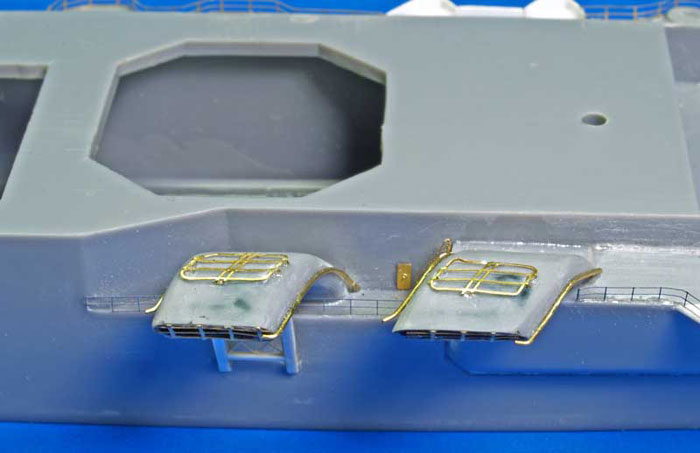
Click the thumbnails below to view larger
images:
[../../photogallery/photo00004769/real.htm]
The ship is painted with my own mix of Model Master
paints with Gunship Gray as the basis. The deck is painted Valejo
Natural Wood color, but this turned out too bright and I toned it down
by airbrushing a translucent medium gray over the yellow, yet it is
still too bright. I masked and airbrushed all deck markings, which took
a very long time to do and was the most tedious part of the ship build.
I weathered the Soryu with oil paints, starting
with various shades of gray going from dark to light, applied in streaks
then blended in with a Q-tip. I represented rust with oil Burnt
Sienna. I then applied a dark wash across the entire ship followed by
light dry brushing of a light gray across horizontal surfaces and some
vertical surfaces.
Next, I added over 250 figures from Eduard’s
excellent pre-painted 1/700 IJN Carrier Figure set. The figures are
tiny and difficult to put into position without leaving a glob of glue
on the deck. I had to sound the “Man Overboard” drill at least 50
times when I lost figures as I was transporting them to the deck or in
the attempt to secure them to the deck. I’m sure the ship’s tiny
Captain was very frustrated with me for losing so many of his sailors.
For the club project we decided to use Fujimi’s
“Japan Naval Plane” 1/700 clear aircraft set. The aircraft are molded
in clear styrene, which molding requirements dictated thick trailing
edges of the wings and tailplanes that required a tremendous amount of
work to thin to an acceptable thinness.
As we are representing the six IJN carriers as they
appeared immediately before the first launch, each aircraft would be
manned and have the canopies opened, though we did not attempt to place
figures in the cockpits. I drilled out each canopy and then squared the
openings with microfiles and X-Acto blades. I cut off the “peg leg”
landing gear and replaced them with photoetched gear from the Lion Roar
IJN Airplane set. For wheels I chopped off tiny slices of
20-thousandths Evergreen rod and superglued them to the landing gear.
The most difficult part was attaching the tiny photoetch tail wheels,
but I feel this added much to the realism of the aircraft, otherwise
they look strange sitting directly on their tails (the Fujimi aircraft
don’t come with any sort of tail wheel.)
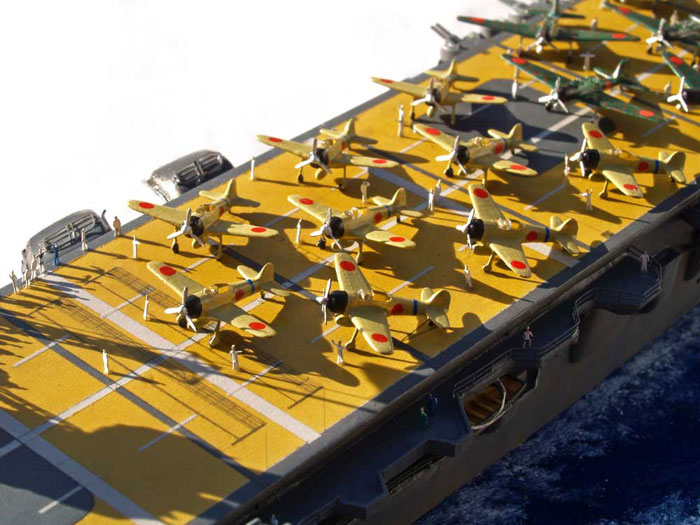
Next I added Lion Roar drop tanks to the Zeros and
thickened them to near circular shape by painting them with thick gloss
enamel paint. For the Kates I added the appropriate number of torpedoes
or bombs as carried by the first Soryu wave. Then finally, again from
the Lion Roar set I added the propellers after twisting each blade to a
somewhat realistic pitch.
I hand painted each aircraft and added the Fujimi
kit decals for the Hinomarus as well as blue tail bands cut from a
Hasegawa 1/72 Zero decal sheet. I must say, the 27 aircraft took a long
time to build, paint and apply decals, a most tedious process that I
didn’t think would ever end.
Mine was the first of the six carriers finished and
we needed a temporary base to display it at the 65h Pearl Harbor
Symposium held in Waikiki.
The base is a simple Johan acrylic display case you
can buy at many hobby shops. For the ocean surface I used “wavy”
Plexiglas that I sprayed with Tamiya spraycan Transparent Blue. When
placed against the black base of the case, the blue looks exactly like
the incredibly beautiful blue of the Pacific Ocean around the Hawaiian
Islands.

I used my daughters acrylic craft paint to create
the bow wave and wake, using a bright blue and white. I mixed the two
together in various shades and dry brushed it on the wavy Plexiglas,
getting lighter and lighter as I went, finishing with pure white. The
paint has a flat finish so I coated it with Future floor finish (a clear
acrylic) to make it glossy. I drilled two holes and glued thick brass
rods to temporarily secure the model to the base.
The model is not glued to the base so it can be
removed and placed on its final base when the other ships in this
project are finished, thus I made no attempt to blend the ship’s hull to
the water.
65th Pearl Harbor Symposium
|
In four and a half months I had the Soryu 95%
complete for the 65th Pearl Harbor Symposium, lacking the
fold-down aerials, figures and other minor details. On the evening of
December 1 2006, IPMS Battleship Row hosted the IJN Pilot’s mixer at the
Hilton Hawaiian Village in Waikiki prior to the beginning of the
Symposium the next morning. The Soryu and several other models were
displayed at the mixer. Three Japanese aviators were present, along
with the staff of the USS Arizona Memorial and other dignitaries from
the US National Parks Department, as well as a several prominent
historians and authors. No December 7th veteran US pilots
were present at the symposium or mixer due to age and health issues.
The Japanese aviators included Zenji Abe, commander
of the Akagi’s 2nd Chutai Val dive-bomber unit, who
dive-bombed CL-7 USS Raleigh on the northwest side of Ford Island.
Warrant Officer Takeshi Maeda from the carrier Kaga was a gunner aboard
a Kate torpedo bomber that attacked Battleship Row. Later, at the
Battle of Midway he was wounded by a bomb that struck his ship. Jiro
Yoshida was an A6M5 Zero pilot who trained near the end of the war but
didn’t have a chance to fly in combat before war’s end.
Early on December 2 2006, we arrived at the banquet
hall to set-up our model display for the opening of the Symposium. Our
display included a scratchbuilt 1/6 model of a Japanese Type 91 torpedo
as used on the Pearl Harbor attack, a 1/12 December 7th
P-40B, 1/48 models of the main US and Japanese aircraft involved in the
attack, as well as two 1/72 Type-A midget subs, my 1/700 Soryu, and of
course, the club’s 1/2400 Battleship Row diorama. We manned the display
through the entire four-day symposium and met some very interesting
people. It was an incredible experience. Club President Brad Sekigawa
built a 1/48 Val in the markings of Zenji Abe’s aircraft and presented
it to him at the symposium.
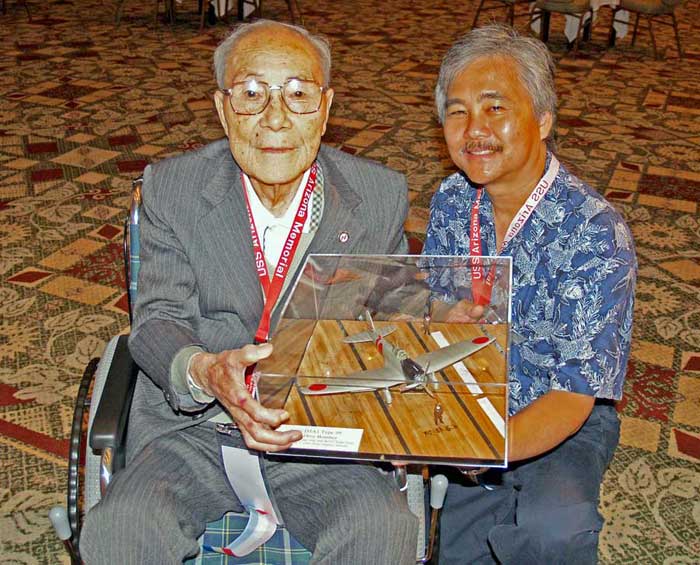
Zenji Abe passed away on April 6 2007.
Photography and Donation of the Model
|
After the symposium, I took six months to almost
finish the remaining 5% of the model.
I had recently retired from the USAF and was moving
from Hawaii to Spokane, Washington, in the summer of 2007, so I had a
strict deadline.
My last Battleship Row model club meeting was on 28
July 2007 and by 4:00PM that afternoon I was still only 99% complete
with the model. After my last session working on the model, I quickly
took the model outside in the late afternoon sunshine and using a plain
white sheet as a backdrop, photographed the model in the direct sunshine
with my Olympus E-500 digital SLR. I did not have my studio equipment
with me, as all my family and I had with us was our baggage to fly with
to the US mainland three days later.
At first I was dismayed that the sun was so low and
the shadows harsh and long, but then I realized this is probably how the
Soryu looked during the second launch against Pearl Harbor when the sun
was just above the horizon, so I was pretty happy with the pictures.
Immediately after taking the pictures I rushed the
model to my last Battleship Row club meeting.
At the Battleship Row Model Club meeting, I donated
the Soryu into the capable hands of club president and friend, Brad
Sekigawa, where the model will continue to educate people from around
the world on the events of December 7 1941.
I would like to thank my friends from IPMS
Battleship Row for their advice and support on this project—mahalo Brad,
Val, Neal, Dean, Mark, Gary, Glen and Layton.
If any of you readers plan on visiting Oahu, I
suggest you attend the IPMS Battleship Row club meeting if possible; you
will meet a great group of fun people. You can check the club calendar
here:
http://ipmshawaii.tripod.com/
Click the thumbnails below to view larger
images:
[../../photogallery/photo00015646/real.htm]
Text and Images Copyright
2007 by Don Hinton
Page Created 06 December, 2007
Last Updated
24 December, 2007
Back to
HyperScale Main Page |
Home
| What's New |
Features |
Gallery |
Reviews |
Reference |
Forum |